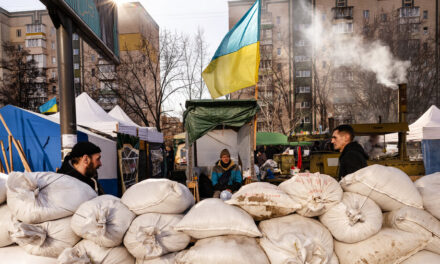
Covid-19 Live Updates: Canada Vaccinates Nursing Home Residents but Keeps Them Isolated

Nursing homes in Canada were prioritized for the first precious doses of coronavirus vaccines to few objections — they were ground zero for the pandemic’s cruel ravage. Around 66 percent of the country’s terminal Covid-19 victims lived in nursing homes, among the highest rates in the world.
But while the vaccines have given the majority of nursing-home residents protection from death by the virus, so far they have not offered more life. Unlike in the United States, where some restrictions at long-term care facilities have been loosened, health officials in Canada say they are waiting for scientific assurance that it is safe to ease regulations.
That has left some residents comparing their lives to those of prisoners and caged animals.
Most places around Canada have policies that allow visits from only one or two designated caregivers, but these measures aren’t evenly carried out. And in several cities, including Toronto and Montreal, residents are not allowed to leave the property to walk to a pharmacy or enjoy the simple pleasure of a stroll down the street.
All this has left some residents frustrated, baffled and wondering: What, exactly, am I being kept alive for?
Officials at provincial and territorial health care ministries around the country, which oversee health care, offer many reasons for not relaxing restrictions: concerns about emerging variants of the virus, the lack of research on the vaccine’s effectiveness in preventing transmission and, in some cases, the high infection rates in the surrounding community.
“We need to better understand the effectiveness of the vaccines in preventing transmission, including variant transmission, before we can safely alter visitor policies,” said Tom McMillan, an Alberta health official.
In the United States, some states have loosened restrictions as cases have dropped, allowing nursing homes to hold group activities like game night or choir practice. And some homes have permitted indoor visits under federal guidelines put in place in September that allow them if a home has been virus-free for 14 days and county positivity rates are below 10 percent, regardless of the home’s vaccination rate.
But elsewhere, homes are about to reach a full year of being closed to visitors, despite the plummeting of coronavirus cases.
The AARP and other advocacy organizations have called on the U.S. government to ease visitation guidelines as vaccines are rolled out in nursing homes. Many note that with vaccinations, the likelihood of residents contracting and dying from Covid-19 is lower, but the harm to residents from social isolation continues unabated.
One large survey of nursing-home residents and their families in Canada found that a majority reported a marked decline in cognitive function and emotional well-being, and almost half reported that their physical functioning had worsened.
The survey also found that the proportion of residents on antipsychotic medication — traditionally prescribed to manage behaviors like agitation related to dementia — had increased by 7 percent over six months.
The question of how to care for the country’s senior population during a pandemic isn’t unique to Canada and the United States. Many nursing homes around the world banned visits as the coronavirus arrived around a year ago.
Soon after, geriatricians sounded the alarm about the rapid decline in health and well-being of residents, setting off a debate about the balance between protection and quality of life, as well as the rights and autonomy of residents. As a result, many jurisdictions reintroduced some sort of visitor policy as the first wave subsided.
Many are calling for a similar discussion to happen again in Canada.

As students in some parts of the United States approach nearly a year without in-person school, new research suggests that the reading skills of young children have suffered during the pandemic.
The research, a preliminary national study from the group Policy Analysis for California Education, found that as of late fall, second graders were 26 percent behind where they would have been, absent the pandemic, in their ability to read aloud accurately and quickly. Third graders were 33 percent behind.
Those differences were equivalent to being able to read seven to eight fewer words per minute accurately.
Some previous research has come to a different conclusion, suggesting that reading skills in third to eighth grade have proven more durable than many experts feared.
The new study relied on audio recordings of one to two minutes, from 98,000 children in 111 school districts across 22 states. The samples were collected by Literably, an online assessment tool. School buildings in the districts included in the study were more likely to be fully or partly closed than those in the average American district.
Crucially, the students lost the expected reading gains in the spring of 2020, when schools abruptly shut down at the outset of the pandemic. Students resumed improving their reading skills in the fall, suggesting schools and teachers improved in their ability to deliver instruction online or in hybrid learning. But those gains were insufficient to make up for the previous losses.
The researchers did not study whether students were able to make up for the spring losses in districts that were more likely to be open in the fall.
Notably, students in lower-achieving school districts included in the study lost more learning than those in higher-achieving districts, suggesting that the pandemic has widened existing achievement gaps. And 10 percent of students who were recorded in the spring were missing from the audio assessments in the fall.
While some of those children may have been enrolled in high-quality alternatives, such as private schools, others may have been absent because of difficulties with access to remote learning, suggesting that learning loss could be even greater for the most vulnerable students.
Heather J. Hough, an author of the working paper, said schools may need to provide tutoring and extra instructional time to help students catch up. But she warned against an approach that focused only on academics, saying that young children needed recess, playtime and social time — some of which have been in short supply during the pandemic — to be able to absorb new information effectively.
“That is as critical to early reading development as the technical skills,” she said.

Russian efforts to spread disinformation about the Moderna and Pfizer vaccines are being monitored by the Biden administration, the White House press secretary, Jen Psaki, said on Monday.
“We will fight with every tool we have,” she said. “We are aware of it, we are monitoring it and we are taking steps to address.”
Three publications run by Russian intelligence services have been identified as seeking to undermine the vaccines, a spokeswoman for the State Department said, according to Reuters, confirming an earlier report by The Wall Street Journal.
Though the publications have a small reach, they have emphasized the risk of the vaccines’ side effects and cast doubts about their efficacy, The Journal reported. (A Kremlin spokesman denied those claims to The Journal.)
Ms. Psaki reiterated on Monday that the vaccines were safe and effective, having gone through a rigorous approval process in the United States.
Late-stage trial results of Russia’s Sputnik V vaccine, published in the British medical journal The Lancet last month, found the vaccine to be safe and effective, but Russia began vaccinating its population in August before such trials had even begun, drawing criticism from Western medical experts.
Russian news outlets connected to election disinformation campaigns in the United States have sought to convince people in Latin American nations that the Sputnik vaccine works better than ones developed in the United States.
Ms. Psaki said the White House was “familiar with” Russian disinformation efforts and that it would “look for ways to combat misinformation.”

The pandemic has forced the Food and Drug Administration to postpone hundreds of drug company inspections, creating an enormous backlog that is delaying new drug approvals and leading the industry to warn of impending shortages of existing medicines.
Pandemic-related travel restrictions and safety concerns have also hampered the F.D.A.’s ability to ensure the safety of the ever-increasing number of imported medicines, which make up more than 60 percent of the drugs sold in the United States.
“Regardless of where drugs are manufactured, domestically or overseas, the F.D.A. has the responsibility to ensure they are effective and safe,” said Mary Denigan-Macauley, the director of health care, public health and private markets for the Government Accountability Office, a congressional watchdog agency. “Any drop in inspections, or backlog, is concerning.”
The numbers show a steep decline. The F.D.A. conducted 52 inspections of domestic pharmaceutical plants from March 2020, when the pandemic took hold in the United States, to Oct. 1, compared with 400 during the same months in 2019, according to the G.A.O. Inspections of foreign manufacturing facilities have been at a virtual standstill for months.
F.D.A. officials said they sharply curtailed the inspections to protect their investigators, following guidelines from the Centers for Disease Control and Prevention, which discouraged federal employees from travel during the pandemic.
But some people in both industry and public health communities say that federal drug inspections are essential, and that the agency should bypass travel restrictions.
“I think they can and they should,” said Dr. Michael Carome, the director of Public Citizen’s Health Research Group, a nonprofit advocacy organization. “They should be considered essential workers and they should be vaccinated as soon as possible.”
In interviews, F.D.A. officials denied that the large drop in inspections had slowed drug approvals. But a number of drug companies, including Spectrum Pharmaceuticals, Biocon Biologics and Bristol Myers Squibb, have issued statements noting deferred F.D.A. action because of the agency’s inability to conduct inspections.

The publisher of Gov. Andrew M. Cuomo’s book on his leadership during the pandemic said it had stopped promoting the title because of an inquiry into the withholding of data on the deaths of nursing home residents.
Sales of the book, “American Crisis: Leadership Lessons from the Covid-19 Pandemic,” had already slowed severely as the governor found himself embroiled in overlapping crises, including a drumbeat of accusations about his inappropriate behavior toward younger women and his aides’ manipulation of nursing home data.
Gillian Blake of Crown Publishing Group said in response to an email from The New York Times that there were “no plans to reprint or to reissue in paperback” Mr. Cuomo’s book, citing “the ongoing investigation into N.Y.S. reporting of Covid-related fatalities in nursing homes.”
The book was published by Crown, a division of Penguin Random House, which rushed to get it into print last year. The publisher celebrated its acquisition in an announcement last summer, describing how Mr. Cuomo, “in his own voice,” would write about “the decision-making that shaped his political policy.”
A spokesman for Mr. Cuomo did not immediately return a request for comment.
Mr. Cuomo and his top aides concealed the actual number of nursing home residents with Covid-19 who died, excluding those who died in hospitals out of the state’s official count for all of last year.
The Cuomo administration released the data in February, after a report by the state attorney general, Letitia James, suggested widespread undercounting. A court ordered the data to be made public after a Freedom of Information lawsuit by the Empire Center, a conservative think tank.
Mr. Cuomo had begun working on the book by early last summer as he received praise for his pandemic leadership and rode a wave of national popularity fueled by his daily news conferences.
The decision to publish a triumphant account of the state’s battle against coronavirus was questioned by some political observers at the time, especially considering the crushing death toll in New York and the second wave of the disease that was looming even as Mr. Cuomo did promotional events. Mr. Cuomo, however, said the book was not premature, arguing it was “halftime” in the pandemic and noting that the manuscript offered a “blueprint for going forward.”
















